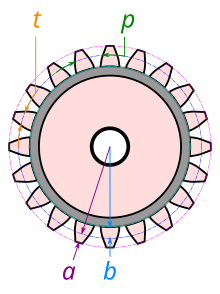
A | B | C | D | E | F | G | H | CH | I | J | K | L | M | N | O | P | Q | R | S | T | U | V | W | X | Y | Z | 0 | 1 | 2 | 3 | 4 | 5 | 6 | 7 | 8 | 9
A gear train or gear set is a machine element of a mechanical system formed by mounting two or more gears on a frame such that the teeth of the gears engage.
Gear teeth are designed to ensure the pitch circles of engaging gears roll on each other without slipping, providing a smooth transmission of rotation from one gear to the next.[2] Features of gears and gear trains include:
- The gear ratio of the pitch circles of mating gears defines the speed ratio and the mechanical advantage of the gear set.
- A planetary gear train provides high gear reduction in a compact package.
- It is possible to design gear teeth for gears that are non-circular, yet still transmit torque smoothly.
- The speed ratios of chain and belt drives are computed in the same way as gear ratios. See bicycle gearing.
The transmission of rotation between contacting toothed wheels can be traced back to the Antikythera mechanism of Greece and the south-pointing chariot of China. Illustrations by the Renaissance scientist Georgius Agricola show gear trains with cylindrical teeth. The implementation of the involute tooth yielded a standard gear design that provides a constant speed ratio.
Gear ratio

Dimensions and terms
The pitch circle of a given gear is determined by the tangent point contact between two meshing gears; for example, two spur gears mesh together when their pitch circles are tangent, as illustrated.[3]: 529
The pitch diameter is the diameter of a gear's pitch circle, measured through that gear's rotational centerline, and the pitch radius is the radius of the pitch circle.[3]: 529 The distance between the rotational centerlines of two meshing gears is equal to the sum of their respective pitch radii.[3]: 533
The circular pitch is the distance, measured along the pitch circle, between one tooth and the corresponding point on an adjacent tooth.[3]: 529
The number of teeth per gear is an integer determined by the pitch circle and circular pitch.
Relationships

- t = tooth thickness, along the pitch circle
- p = circular pitch, along the pitch circle
- a = addendum, radially
- b = dedendum, radially
The circular pitch of a gear can be defined as the circumference of the pitch circle using its pitch radius divided by the number of teeth :[3]: 530
The thickness of each tooth, measured through the pitch circle, is equal to the gap between neighboring teeth (also measured through the pitch circle) to ensure the teeth on adjacent gears, cut to the same tooth profile, can mesh without interference. This means the circular pitch is equal to twice the thickness of a tooth,[3]: 535
In the United States, the diametral pitch is the number of teeth on a gear divided by the pitch diameter; for SI countries, the module is the reciprocal of this value.[3]: 529 For any gear, the relationship between the number of teeth, diametral pitch or module, and pitch diameter is given by:
Since the pitch diameter is related to circular pitch as
this means
Rearranging, we obtain a relationship between diametral pitch and circular pitch:[3]: 530
Gear or speed ratio

For a pair of meshing gears, the angular speed ratio, also known as the gear ratio, can be computed from the ratio of the pitch radii or the ratio of the number of teeth on each gear. Define the angular speed ratio of two meshed gears A and B as the ratio of the magnitude of their respective angular velocities:
Here, subscripts are used to designate the gear, so gear A has a radius of and angular velocity of with teeth, which meshes with gear B which has corresponding values for radius , angular velocity , and teeth.
When these two gears are meshed and turn without slipping, the velocity of the tangent point where the two pitch circles come in contact is the same on both gears, and is given by:[3]: 533
Rearranging, the ratio of angular velocity magnitudes is the inverse of the ratio of pitch circle radii:
Therefore, the angular speed ratio can be determined from the respective pitch radii:[3]: 533, 552
For example, if gear A has a pitch circle radius of 1 in (25 mm) and gear B has a pitch circle radius of 2 in (51 mm), the angular speed ratio
Antropológia
Aplikované vedy
Bibliometria
Dejiny vedy
Encyklopédie
Filozofia vedy
Forenzné vedy
Humanitné vedy
Knižničná veda
Kryogenika
Kryptológia
Kulturológia
Literárna veda
Medzidisciplinárne oblasti
Metódy kvantitatívnej analýzy
Metavedy
Metodika
Text je dostupný za podmienok Creative
Commons Attribution/Share-Alike License 3.0 Unported; prípadne za ďalších
podmienok.
Podrobnejšie informácie nájdete na stránke Podmienky
použitia.
www.astronomia.sk | www.biologia.sk | www.botanika.sk | www.dejiny.sk | www.economy.sk | www.elektrotechnika.sk | www.estetika.sk | www.farmakologia.sk | www.filozofia.sk | Fyzika | www.futurologia.sk | www.genetika.sk | www.chemia.sk | www.lingvistika.sk | www.politologia.sk | www.psychologia.sk | www.sexuologia.sk | www.sociologia.sk | www.veda.sk I www.zoologia.sk



























